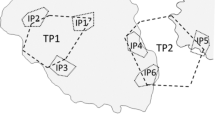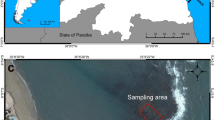Abstract
We studied territoriality and habitat use by yellow phase juvenile blue tangs, Acanthurus coeruleus, on a small fringing reef in Barbados, West Indies. Juvenile blue tangs occurred on the reef crest, spurs, and a transition zone between the reef crest and reef flat at a density of about 8 individuals per 100 m2, but were much rarer on the reef flat. They were solitary and occupied stable home ranges (median=0.85 m2) that increased with body size. Observational and experimental data documented aggressive defense of home ranges against conspecific and to a lesser extent congeneric, A. bahianus, juveniles (about 7.5 approaches and attacks per hour directed at intruders). Home range locations were structurally more complex and closer to a vertical face than expected by chance. Although juvenile blue tang territories overlapped considerably with those of larger and more aggressive Stegastes damselfish, which are believed to exclude solitary adult Acanthurus spp. from reef crest and spurs, the tangs avoided Stegastes and were rarely chased (<0.3 fleeing events per hour). Space use and social organization of yellow juvenile blue tangs contrast strikingly with that of both conspecific adults and congeneric juveniles.
Similar content being viewed by others
References cited
Burt, W.H. 1943. Territoriality and home range concepts as applied to mammals. J. Mammal. 24: 346–352.
Chapman, M.R. & D.L. Kramer. 2000. Movements of fishes within and among fringing coral reefs in Barbados. Env. Biol. Fish. 57: 11–24.
Clarke, T.A. 1970. Territorial behaviour and population dynamics of a pomacentrid fish, the Garibaldi, Hypsypops rubicunda. Ecol. Monogr. 40: 189–212.
Debrot, A.O. & A.A. Myrberg Jr. 1988. Intraspecific avoidance as a proximate cause for mixed-species shoaling by juveniles of a Western Atlantic surgeonfish Acanthurus bahianus. Bull. Mar. Sci. 43: 104–106.
Foster, S.A. 1985a. Group foraging by a coral reef fish: a mechanism for gaining access to defended resources. Anim. Behav. 33: 782–792.
Foster, S.A. 1985b. Size-dependent territory defense by a damselfish. Oecologia 67: 499–505.
Grant, J. 1997. Territoriality. pp. 81–103. In: J.-G.J. Godin (ed.) Behavioural Ecology of Teleost Fishes, Oxford University Press, Oxford.
Itzkowitz, M. 1974. A behavioural reconnaissance of some Jamaican reef fishes. Zool. J. Linn. Soc. 55: 87–118.
Kramer, D.L. & M.R. Chapman. 1999. Implications of fish home range size and relocation for marine reserve function. Env. Biol. Fish. 55: 65–79.
Kramer, D.L., R.W. Rangeley & L.J. Chapman. 1997. Habitat selection: patterns of spatial distribution from behavioural decisions. pp. 37–80. In: J.-G.J. Godin (ed.) Behavioural Ecology of Teleost Fishes, Oxford University Press, Oxford.
Lawson, G.L., D.L. Kramer & W. Hunte. 1999. Size-related habitat use and schooling behaviour in two species of surgeonfish (Acanthurus bahianus and A. coeruleus) on a fringing reef in Barbados, West Indies. Env. Biol. Fishes 54: 19–33.
Lewis, J.B. 1960. The coral reefs and coral communities of Barbados, W.I. Can. J. Zool. 38: 1133–1145.
Luckhurst, B.E. & K. Luckhurst. 1978. Analysis of the influence of the substrate variables on coral reef fish communities. Mar. Biol. 49: 317–323.
McNicol, R.E., E. Scherer & E.J. Murkin. 1985. Quantitative field investigation of feeding and territorial behaviour of young-of the-year brook charr, Salvelinus fontinalis. Env. Biol. Fish. 12: 219–229.
Nielson, L.A. 1992. Methods of marking fish and shellfish. American Fisheries Society, Bethesda. 208 pp.
Noble, G.K. 1939. The role of dominance in the social life of birds. Auk 56: 263–273.
Nursall, J.R. 1974. Some territorial behavioural attributes of the surgeonfish Acanthurus lineatus at Heron Island, Queensland. Copeia 1974: 950–959.
Pastorak, R.A. & G. T. Bilyard. 1985. Effects of sewage pollution on coral-reef communities. Mar. Ecol. Prog. Ser. 21: 175–189.
Rakitin, A. & D.L. Kramer. 1996. Effect of a marine reserve on the distribution of coral reef fishes in Barbados. Mar. Ecol. Prog. Ser. 131: 97–113.
Rice, W.R. 1989. Analyzing tables of statistical tests. Evolution 43: 223–225.
Risk, A. 1997. Effects of habitat on the settlement and postsettlement success of the ocean surgeonfish Acanthurus bahianus. Mar. Ecol. Prog. Ser. 161: 51–59.
Risk, A. 1998. The effects of interactions with reef residents on the settlement and subsequent persistence of ocean surgeonfish. Env. Biol. Fish. 51: 377–389.
Roberts, C.M. 1986. Methods for the study of territoriality. pp. 81–93. In: G.W. Potts (ed.) Report of the 19th Symposium of the Underwater Association at the British Museum (Natural History), The Underwater Association for Scientific Research, Kent.
Robertson, D.R., N.C. Polunin & K. Leighton. 1979. The behavioural ecology of the Indian Ocean surgeonfishes (Acanthurus lineatus, A. leucosternum, and Zebrasoma scopas): their feeding strategies, and social and mating systems. Env. Biol. Fish. 4: 125–170.
Russ, G.R. 1987. Is the rate of removal of algae by grazers reduced inside the territories of tropical damselfishes? J. Exp. Mar. Biol. Ecol. 110: 1–17.
Schoener, T.W. 1981. An empirically based estimate of home range size. Theor. Pop. Biol. 20: 281–325.
Shulman, M.J. 1985. Coral reef fish assemblages: intra-and interspecific competition for shelter sites. Env. Biol. Fish. 13: 81–92.
Thresher, R.E. 1976. Field analysis of the territoriality of the threespot damselfish Eupomacentrus planifrons (Pomacentridae). Copeia 1976: 266–276.
Thresher, R.E. 1978. Territoriality and aggression in the threespot damselfish (Pisces; Pomacentridae): an experimental study of causation. Z. Tierpsychol. 46: 401–434.
Thresher, R.E. 1984. Reproduction in reef fishes. T.F.H. Publications, Neptune City. 399 pp.
Tomascik, T. & F. Sander. 1987. Effects of eutrophication on reefbuilding corals II. Structure of scelactinian coral communities on fringing reefs, Barbados, West Indies. Mar. Biol. 94: 53–75.
Wolf, N.G. 1985. Odd fish abandon mixed-species groups when threatened. Behav. Ecol. Sociobiol. 17: 47–52.
Author information
Authors and Affiliations
Rights and permissions
About this article
Cite this article
Bell, T., Kramer, D.L. Territoriality and Habitat Use by Juvenile Blue Tangs, Acanthurus coeruleus . Environmental Biology of Fishes 58, 401–409 (2000). https://doi.org/10.1023/A:1007653318174
Issue Date:
DOI: https://doi.org/10.1023/A:1007653318174




